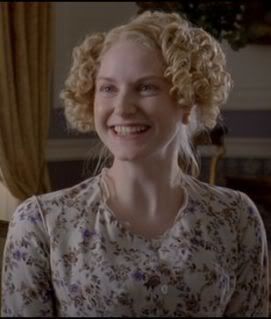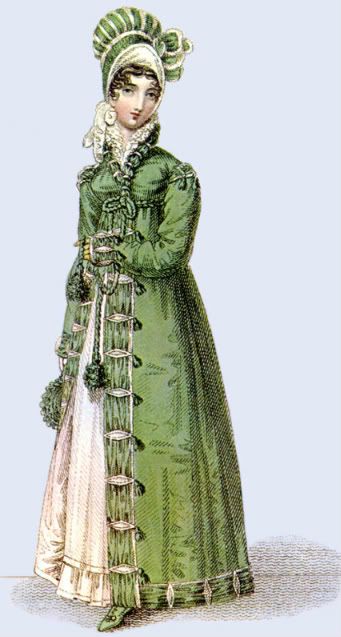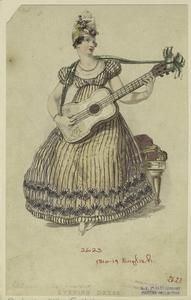 |
| Source |
Instead of drastic changes in the shape and fabric of garments like those that took place in the 1790's and are to come in the 1820's and 30's, the changes that took place in fashion in the 1800's and 10's are much more subtle and miniscule. Hairstyles stayed pretty static during the first few decades of the century, but during the late 1800's and 1810's there came the trend of wearing curls over the ears.
 |
| Sported here by Louise Dylan portraying Harriet Smith. |
One thing that I keep noticing as I research the 1810's is the advent of the trim.
 |
| Source |
Dresses from the beginning of the decade, like the one shown above, seem to have light, embroidered trims around the skirt. White-on-white embroidery was very popular near the beginning of the century.
As the decade wears on, trims seem to become more three-dimensional, and in different colors from the main garment. Trims took many forms, such as ruffles and flower accents.
 |
| A floral accent trim. The skirts seem to be getting slightly fuller as the decade wears on. |
By the end of the decade, trim wasn't just on the edge of the skirt, but on sleeves, spencers, shoulders, necklines, and as shown in the image below, bonnets.
 |
| Source |
 |
| Source |
As French travel and trade became safe and politically correct once again, this change to more glamour and frippery would continue to increase. The ever-turning wheels of fashion evolution were once again in motion. As we venture into the 1820's, we'll begin to see an age where the hair accessory is king (queen?) and The Fall of the Empire Waistline (insert thunderclap).

No comments:
Post a Comment
,mmmmmmmmmmmmmmmmmmmmmmmmmmmmmmmmmmmmmmmmmmmmmmmmmmmmmmmmmmmmmmmmmmmmmmmmmmmmmmmmmmmmmmmmmmmmmmmmmmmmmmmmmmmmmmmmmmmmmmmm'aaaaaaaaaaaakAAAQA
I was going to type something clever, but my cat provided this triumph of literature. Thank you for commenting! Just keep it clean, on-topic, and respectful.